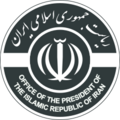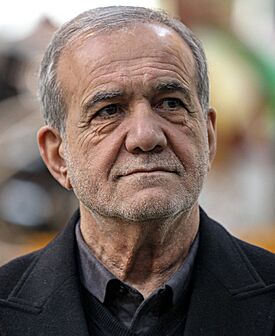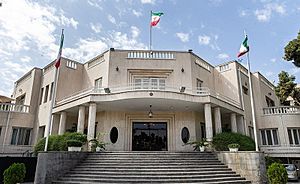President of Iran facts for kids
Quick facts for kids President of theIslamic Republic of Iran |
|
|---|---|

Seal of the Presidential Administration of Iran
|
|
| Presidential Administration | |
| Style | Mr. President |
| Member of |
|
| Residence |
|
| Seat | Pasteur Street, Tehran |
| Appointer | Direct vote |
| Term length | 4 years, renewable once consecutively |
| Formation | 4 February 1980 |
| First holder | Abolhassan Banisadr |
| Deputy | First Vice President |
| Salary | 2155 USD annually (538,592,400 ﷼)(as of 2019) |
The President of the Islamic Republic of Iran is the head of government in Iran. This person is the second most important official, right after the Supreme Leader. The first election for president happened in 1980. Abulhassan Banisadr won that election. Currently, Masoud Pezeshkian is the President of Iran. He was elected in the 2024 Iranian presidential election and approved by the Supreme Leader.
Contents
History of Iran's Presidency
After the Iranian Revolution in 1979, Iran needed a new government plan. The Supreme Leader, Ruhollah Khomeini, asked for an election to choose people who would write a new constitution. This group was called the Assembly of Experts. They finished the constitution on October 24, 1979. Both Supreme Leader Ruhollah Khomeini and Prime Minister Mehdi Bazargan approved it.
The 1979 Constitution said that the Supreme Leader was the country's main leader. It also said the president and prime minister would lead the government. In 1989, the job of prime minister was removed.
First Presidents of Iran
The first presidential election in Iran was on January 25, 1980. Abulhassan Banisadr was elected with 76% of the votes. However, Banisadr was removed from office by the Parliament on June 22, 1981. A temporary council took over until a new election.
Mohammad-Ali Rajai was elected president on July 24, 1981. He started his job on August 2. Rajai was president for less than a month. He and his prime minister were killed in a bombing. Another temporary council took charge. Then, on October 13, 1981, Ali Khamenei was elected president.
Recent Presidents
Several presidents have served two terms. These include Ali Khamenei, Akbar Hashemi Rafsanjani, Mohammad Khatami, Mahmoud Ahmadinejad, and Hassan Rouhani.
The most recent president before the current one was Ebrahim Raisi. He took over from Hassan Rouhani, who was president for eight years (2013-2021). On May 19, 2024, a helicopter carrying Raisi crashed. There were no survivors. Raisi was the second president of Iran to die while in office. After his death, the first vice president, Mohammad Mokhber, became the acting president. New elections were then held on June 28, 2024.
How the President's Office Works
Before becoming president, a person needs the Supreme Leader's official approval. Then, the Parliament officially swears them in. The Supreme Leader can also remove the president from office. This can happen if Parliament removes them or if the Supreme Court finds them guilty of breaking the constitution.
The Supreme Leader has the most power in Iran. The president follows the Supreme Leader's orders. Unlike leaders in many other countries, Iran's president does not have full control over the government. The Supreme Leader ultimately controls everything.
Before elections, people who want to be president must be approved by the Guardian Council. The Supreme Leader chooses the members of the Guardian Council. The President of Iran is elected for a four-year term. People vote directly for the president. A president can only serve two terms in a row.
Presidential Duties and Powers
The Constitution of the Islamic Republic of Iran explains what a president needs to be. The Supreme Leader sets the rules for presidential elections and all other elections in Iran. The president carries out the Supreme Leader's decisions and wishes. This includes signing agreements with other countries and managing national plans and the government's budget.
The president chooses ministers for the government. However, Parliament and the Supreme Leader must approve these choices. The Supreme Leader can also remove or bring back any minister or vice president at any time. The Supreme Leader also directly picks ministers for defense, intelligence, foreign affairs, and interior.
Iran's foreign policy is controlled by the Supreme Leader's office. The Ministry of Foreign Affairs mostly handles formal events. For example, the Quds Corps, which reports to the Supreme Leader, chooses all of Iran's ambassadors to Arab countries.
The current Supreme Leader, Ali Khamenei, has led Iran for over thirty years. He makes the final decisions on many things. These include the economy, education, environment, and foreign policy. He also decides how transparent elections are. He has even fired and rehired people in the president's cabinet.
Becoming a Candidate and Election Process
The Supreme Leader sets the rules for presidential elections. All adults aged 18 and older can vote for the president. Presidents can be reelected only once if they serve two terms in a row.
People who want to be president must be approved by the Council of Guardians. This council has twelve members. Six are religious leaders chosen by the Supreme Leader. The other six are lawyers. The Supreme Leader-appointed head of Iran's judicial system suggests these lawyers, and the Majles approves them.
Candidate Qualifications
The Constitution of Iran says presidential candidates must have these qualities:
- Be of Iranian origin.
- Have good management skills.
- Have a good past record.
- Be trustworthy and religious.
- Believe strongly in the main ideas of the Islamic Republic of Iran.
The Council of Guardians checks these rules. They can reject candidates they don't think are suitable. This process means only a few candidates are usually approved. For example, in the 1997 Iranian presidential election, only four out of 238 candidates were approved. Some people outside Iran say this process helps the council and Supreme Leader make sure only certain types of candidates can win. The council says this is not true.
The president must win more than half of the votes. If no one gets a majority in the first round, the top two candidates have a second election.
The president also automatically becomes the head of the Supreme National Security Council. They also lead the Supreme Council of Cultural Revolution.
Can a Woman Be President?
Whether women can run for president depends on how a certain rule is understood. Article 115 of the Iranian constitution says the president must be chosen from "religious and political men" or "religious and political personalities." The Persian words can be understood both ways. In 1997, the Guardian Council used the first meaning to reject a woman candidate, Azam Taleghani. However, before the 2021 election, a spokesperson for the Guardian Council said there is no legal reason why a woman cannot be president.
What Happens if a President Can't Serve?
According to Article 131 of the Iranian constitution, if the president dies, resigns, is removed, or is sick for more than two months, the first deputy takes over. The Supreme Leader must approve this. A special council then has 50 days to arrange a new election. This council includes the speaker of Parliament, the Chief Justice, and the first deputy. If the first deputy also cannot serve, the Supreme Leader chooses someone else.
President's Powers and Responsibilities
The president's duties are overseen and approved by the Supreme Leader. These duties include:
- Being the second-in-command of the government's executive branch.
- Leading the cabinet.
- Being the deputy commander-in-chief of the Islamic Republic of Iran Army.
- Announcing a state of emergency after Parliament approves it.
- Leading the Supreme National Security Council.
- Leading the Supreme Council of the Cultural Revolution.
- Appointing the first vice president and other vice presidents.
- Suggesting Cabinet members to the Parliament.
- Sending and receiving foreign ambassadors.
- Issuing official decrees.
- Giving out medals for service to the country.
- Signing treaties and contracts after Parliament approves them.
- Signing off on referendum results and laws passed by Parliament and the judiciary.
Latest Election Results
| Candidate | Party | First round | Second round | ||||
|---|---|---|---|---|---|---|---|
| Votes | % | Votes | % | ||||
| Independent | Reformists | 10,415,991 | 44.36 | 16,384,403 | 54.76 | ||
| Independent | Principlists | 9,473,298 | 40.35 | 13,538,179 | 45.24 | ||
| Progress and Justice Population of Islamic Iran | Principlists | 3,383,340 | 14.41 | ||||
| Combatant Clergy Association | Principlists | 206,397 | 0.88 | ||||
| Total | 23,479,026 | 100.00 | 29,922,582 | 100.00 | |||
| Valid votes | 23,479,026 | 95.70 | 29,922,582 | 98.01 | |||
| Invalid/blank votes | 1,056,159 | 4.30 | 607,575 | 1.99 | |||
| Total votes | 24,535,185 | 100.00 | 30,530,157 | 100.00 | |||
| Registered voters/turnout | 61,452,321 | 39.93 | 61,452,321 | 49.68 | |||
| Source: ISNA, IranIntl, Tejarat News | |||||||
See also
 In Spanish: Presidente de Irán para niños
In Spanish: Presidente de Irán para niños
- List of presidents of Iran
- Advisor to the President of Iran
- Aide to the President of Iran
- Chief of Staff of the President of Iran
- First Lady of Iran




